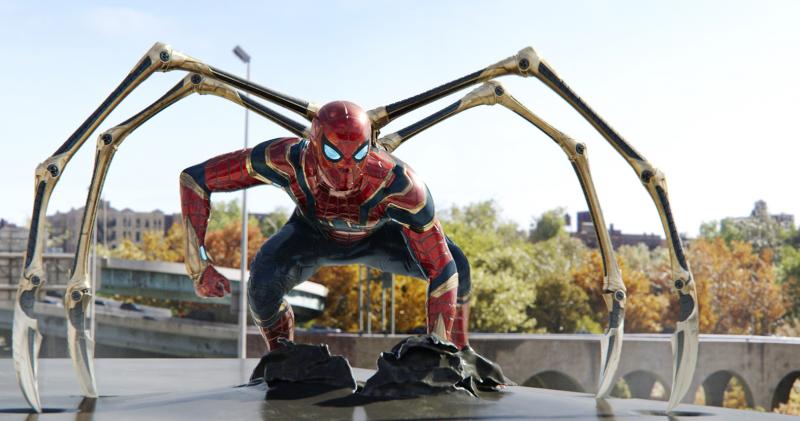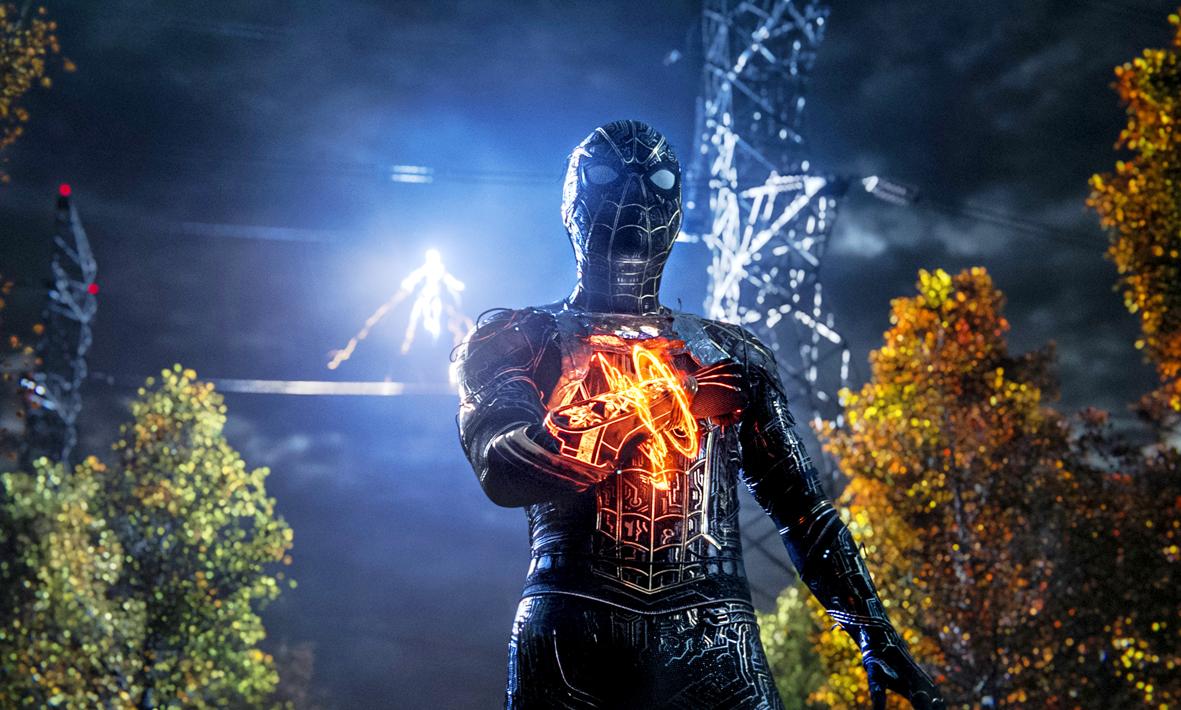Spider-Man movies have come in such flurries over the last two decades that you could almost tell time by them. Who needs the long centuries of the Triassic, Jurassic and the Cretaceous, when, in the span of just one generation you can have the Tobey epoch, the Garfield era and the Tomozoic? The franchise’s constant (and contractual) regenerative velocity has by now become a familiar punchline. But in Spider-Man: No Way Home, the distinct, if cluttered, time zones of Marvel’s webslinger overlap and collide in ways that are often entertaining and likely to be satisfying to fans, even if they still lack quite the Spidey sense tingle they’re designed to provide an overdose of.
This movie is like two Spider-Man jabs and a booster all in one. In its retrospective sweep and supergroup construction, No Way Home is Spidey’s own Endgame.
That also means it comes with plenty of twists that, if you don’t want spoiled, you really ought to see the movie before reading reviews like this one. The clever reveals and appearances of No Way Home are so much a part of its fabric that’s it’s difficult to consider the movie without referencing some of them. In a message before the film, Jamie Foxx (who played the villain Electro in The Amazing Spider-Man 2) warns of revealing spoilers before it’s pointed out that he, himself, is a spoiler.

photo: AP
Jon Watts’ No Way Home begins as its two previous installments, also directed by Watts, did: with the breezy high-school vibe that has characterized Tom Holland’s reign as Spider-Man. It’s been a chapter defined by Holland’s wholesome charm. He’s a pleasant, if somewhat vanilla Spider-Man, who has sometimes seemed most suited to the role offscreen, as student to Robert Downey Jr. and in his genial, goofy media appearances.
But Holland’s earnest, easy manner has also lightened the sometimes heavy load of Marvel movies, and his mostly winning albeit easily forgotten Spider-Man films have been refreshingly unencumbered by the larger franchise’s exposition-leaden, interconnected apparatus.
No Way Home picks up precisely where 2019’s Far From Home left off: Outside New York’s Penn Station, where Jake Gyllenhaal’s Mysterio revealed Peter Parker’s identity just before perishing. The new notoriety brings news helicopters hovering over Peter’s apartment and disrupts his previously clandestine relationship with girlfriend MJ (Zendaya) and best pal Ned (Jacob Batalon). They are on the cusp of getting into MIT (Paula Newsome is especially good as a college admissions officer), but Mysterio has made Peter a divisive figure.

photo: AP
Our stay in Midtown High School, where Peter is mobbed, is brief — too brief, considering the teaching staff includes JB Smoove, Hannibal Buress and Martin Starr.
Wanting his old anonymity back, Peter turns to Benedict Cumberbatch’s Doctor Strange, who summons an amnesia spell that goes awry. Instead of wiping the memory of those who know Spider-Man’s secret, it conjures villains from Spider-mans past, opening portals between parallel universes — which in this case means between movies. Electro, Green Goblin (Willem Dafoe), Doctor Octopus (Alfred Molina), Sandman (Thomas Haden Church) and Lizard (Rhys Ifans) tumble forth like dazed travelers who took a wrong turn at Albuquerque.
By opening pathways of connection between the Spider-Man films, No Way Home binds together a much-remade fictional universe with a new spirit of cohesion and a warm bath of fan service. If we are stepping between movies, it’s tempting to want some of the portals to lead into other films — to Cumberbatch’s character in The Power of the Dog or Andrew Garfield in Tick, Tick ... Boom! Or better yet, Dafoe’s mad wickie in The Lighthouse. Now that would be meta.
Really, it was the Chris Miller and Phil Lord-produced Into the Spider-verse that opened this gateway by riffing metaphysically with the webslinger. No Way Home adopts some of that comic energy but doesn’t have the same whip-smart, freewheeling uninhibitedness. If Spider-verse was about how anyone can be Spider-Man, No Way Home is a more authorized Spider-Man compendium; its tone leans more operatic than antic. Still, Watts has a human touch that can be lacking in superhero films, and nearly all of the actors who appear in No Way Home come across as individuals despite the high-concept narrative.
It also offers a more direct compare and contrast between our three Spider-Men, each a variant of the same theme. The Sam Raimi films, with Tobey Maguire — or at least the first two — are still top of the class.
But while Garfield’s pair of movies are probably the easiest to dismiss, it’s his appearance here that’s the most potent. Not because he’s at home as Spider-Man but because he isn’t. Now seven years older and doing some of the best work of his life, a more mature Garfield exudes something that doesn’t enter into this ever-recycling, short-term-memory franchise — that there is life after Spider-Man.

One of the most important gripes that Taiwanese have about the Democratic Progressive Party (DPP) is that it has failed to deliver concretely on higher wages, housing prices and other bread-and-butter issues. The parallel complaint is that the DPP cares only about glamor issues, such as removing markers of Chinese Nationalist Party (KMT) colonialism by renaming them, or what the KMT codes as “de-Sinification.” Once again, as a critical election looms, the DPP is presenting evidence for that charge. The KMT was quick to jump on the recent proposal of the Ministry of the Interior (MOI) to rename roads that symbolize

On the evening of June 1, Control Yuan Secretary-General Lee Chun-yi (李俊俋) apologized and resigned in disgrace. His crime was instructing his driver to use a Control Yuan vehicle to transport his dog to a pet grooming salon. The Control Yuan is the government branch that investigates, audits and impeaches government officials for, among other things, misuse of government funds, so his misuse of a government vehicle was highly inappropriate. If this story were told to anyone living in the golden era of swaggering gangsters, flashy nouveau riche businessmen, and corrupt “black gold” politics of the 1980s and 1990s, they would have laughed.

It was just before 6am on a sunny November morning and I could hardly contain my excitement as I arrived at the wharf where I would catch the boat to one of Penghu’s most difficult-to-access islands, a trip that had been on my list for nearly a decade. Little did I know, my dream would soon be crushed. Unsure about which boat was heading to Huayu (花嶼), I found someone who appeared to be a local and asked if this was the right place to wait. “Oh, the boat to Huayu’s been canceled today,” she told me. I couldn’t believe my ears. Surely,

When Lisa, 20, laces into her ultra-high heels for her shift at a strip club in Ukraine’s Kharkiv, she knows that aside from dancing, she will have to comfort traumatized soldiers. Since Russia’s 2022 invasion, exhausted troops are the main clientele of the Flash Dancers club in the center of the northeastern city, just 20 kilometers from Russian forces. For some customers, it provides an “escape” from the war, said Valerya Zavatska — a 25-year-old law graduate who runs the club with her mother, an ex-dancer. But many are not there just for the show. They “want to talk about what hurts,” she